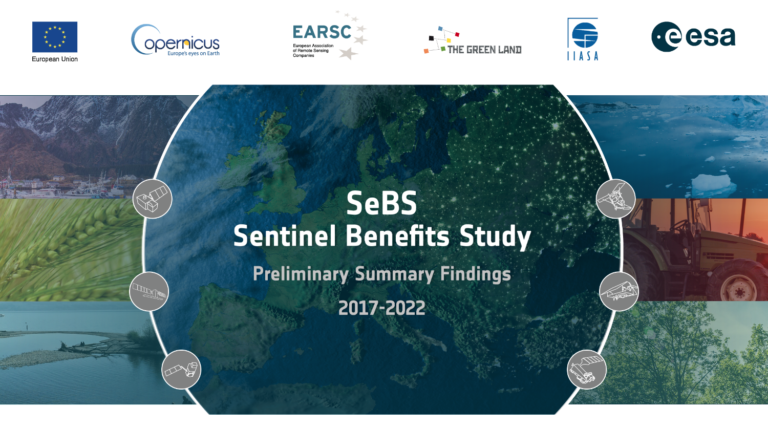e-shape fostering and bridging the European Earth Observation ecosystem
EARSC is one of
the leading partners of the 54 members consortium of e-shape (EuroGEO
Showcases: Applications Powered by Europe), a 48-month project, lead by ARMINES, and constituted by a pan-European
team of academic, industrial, institutional and user communities. Driven by the
need to develop operational EO services with and for the users, e-shape
is federating communities to increase the knowledge and the awareness on European
EO capabilities and new approaches.
e-shape currently includes 27 cloud-based
pilot applications under 7 thematic areas to address societal challenges,
foster entrepreneurship and support sustainable development, in alignment to the
three main priorities of GEO, namely the Sustainable Development Goals (SDGs),
the Paris Agreement and Sendai Framework.
e-shape allows
Europe to position itself as a global force in Earth observation through leveraging
Copernicus, opening new opportunities and expand its use, through the existing
European capacities, as well as developing research to
business activities.
One of the
objectives of EARSC is to invest and promote the users’ uptake of pilots at
national and international scale, across vertical markets (private and public)
and among key users’ communities; as well as support their sustainability.
e-shape boosts a rich portfolio of innovative key pilots participating in the project.
The seven
showcases are:
The food
Security and Sustainable Agriculture showcase: largely
contribute to SDG 2, it consists of four pilots, which all display Copernicus
data sets combined with the necessary in-situ data, weather and soil data that
can deliver improved information at global, national and local scale,
exploiting the processing infrastructures offered by Copernicus DIAS.
The
health Surveillance showcase: will contribute to SDG 3. The three pilots are
dedicated to surveillance of pollutants in the environment and their impact on
public health through in-situ and space-based environmental observations. They
can improve the policy making process and support the assessment of the
effectiveness of measures undertaken by nations to achieve the goals of
international conventions such as the Minamata convention.
The Renewable Energy showcase: through its 3 pilots, will engage
collaborations between research centres, data providers and end users both in
the private and public energy sector. It focuses on SDG 7 and will provide from
different European EO sources, innovative and technology mature products and
services for renewable energy development and management.
The myEcosystem showcase: will serve focal user groups such as research, environmental assessment, reporting and management by offering seamless access to consistently scaled environmental information on ecosystems from various sources. It will serve SDG 11, 14 and 15. It is formed by three highly complementary pilots, developed to maximize services to user groups both in their specific topical areas, but specifically through integrating and jointly using information from remote sensing (mySPACE), in-situ observation (mySITE) and high-level indicators verification and testing with an exemplary focus on biodiversity (myVARIABLE).
The Water resources management showcase: reflects its multidisciplinary by presenting five pilot activities that
focus on its different elements, going from inland waters to coastal areas and
the ocean, providing a link to most of the European Directives and Policies and
the SDG 6, 7, 13 and 14. These pilot activities will be coordinated by leading
institutions and companies of their respective areas, based on work developed
in the scope of previous projects and bringing onboard a significant user base
to co-design, test and validate the provided services. The pilots will be
integrated in NextGEOSS.
The Disasters Resilience showcase: deals with a
portfolio of services focusing on natural and human induced disasters
(geo-hazards, extreme weather, fires, floods, etc.) aiming at protecting
citizens, economies and ecosystems. It is in line with the priorities and the
goals set by the Sendai Framework on Disaster Risk Reduction and SDG2 and
SDG11. The focus of the showcase, of which the pilots are formed, is to build
an effective strategy for successful innovative products leading towards
commercialization of EO services that is being composed of the active
participation/involvement of both private and public sector (co-designers).
The Climate showcase: is contributing to SDG 13 and to the Paris Agreement. Through its pilots, it will exhibit services to public, private and academia users having a variety of cases from local city scale to global focus. The factor uniting most of these efforts will be seasonal forecast information from the Copernicus Climate Change Services C3S.
Acknowledgment.
The e-shape project has received funding from the European Union’s Horizon 2020
research and innovation programme under grant agreement 820852
Discover more
about each pilot here: https://e-shape.eu/index.php/showcases
For more
information, you can follow e-shape and EARSC to stay up to
date.






